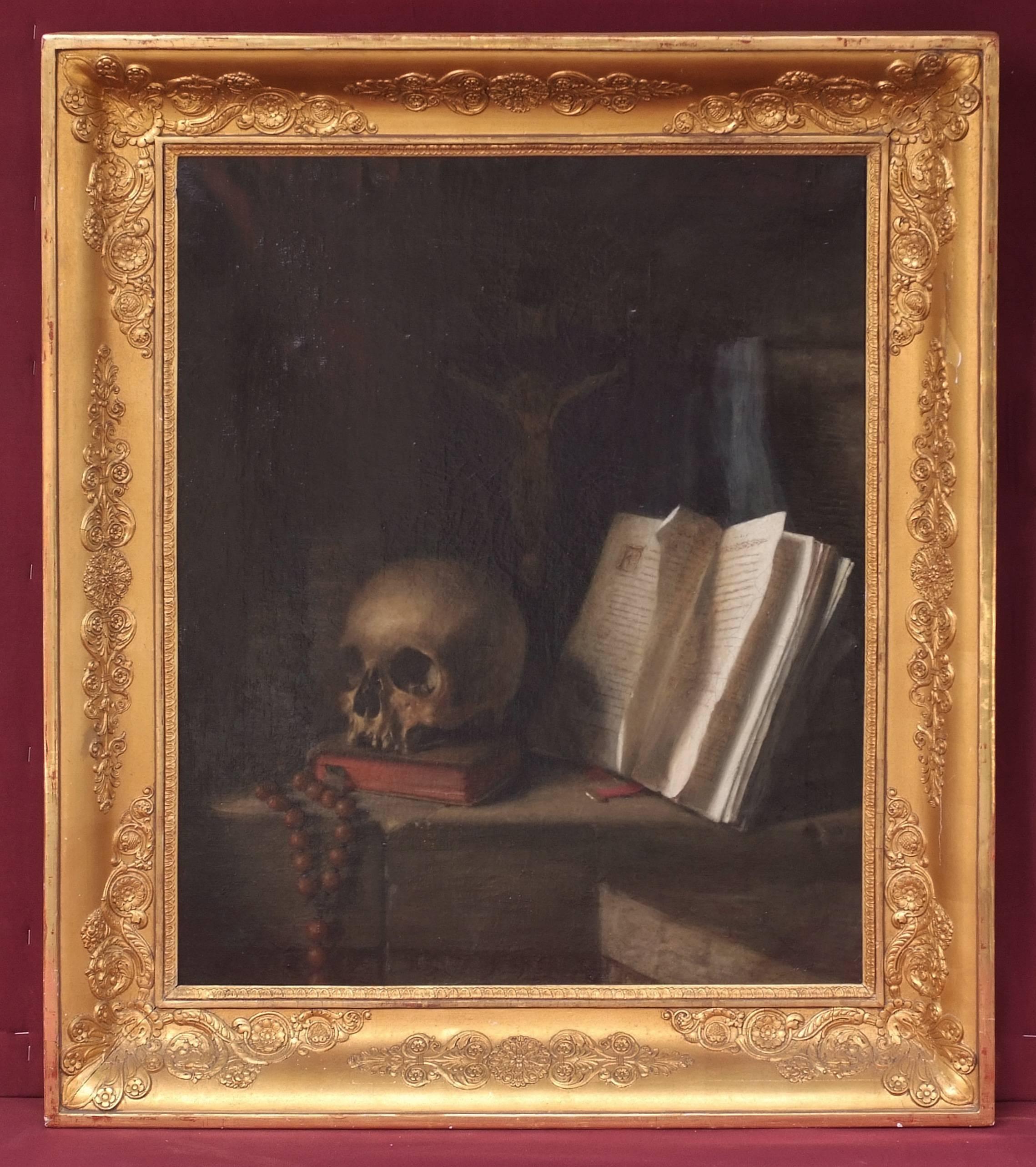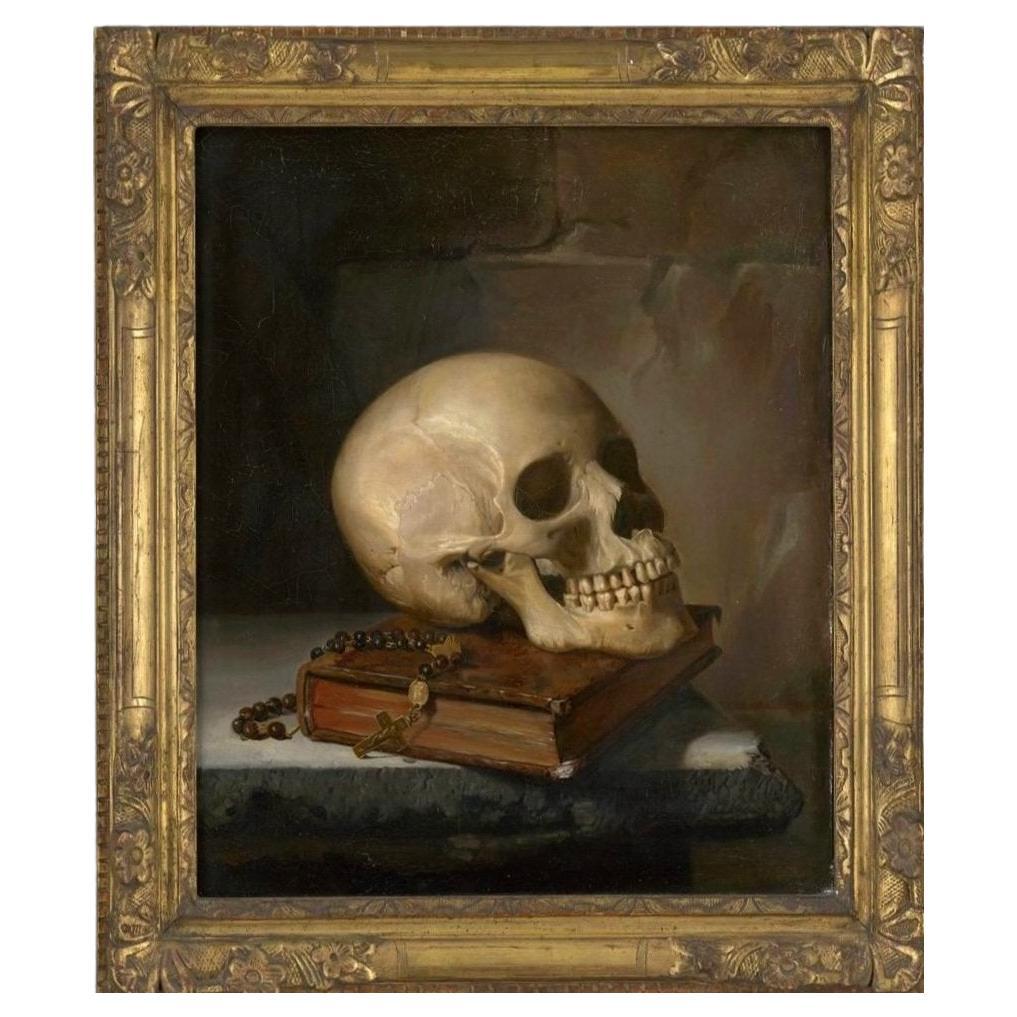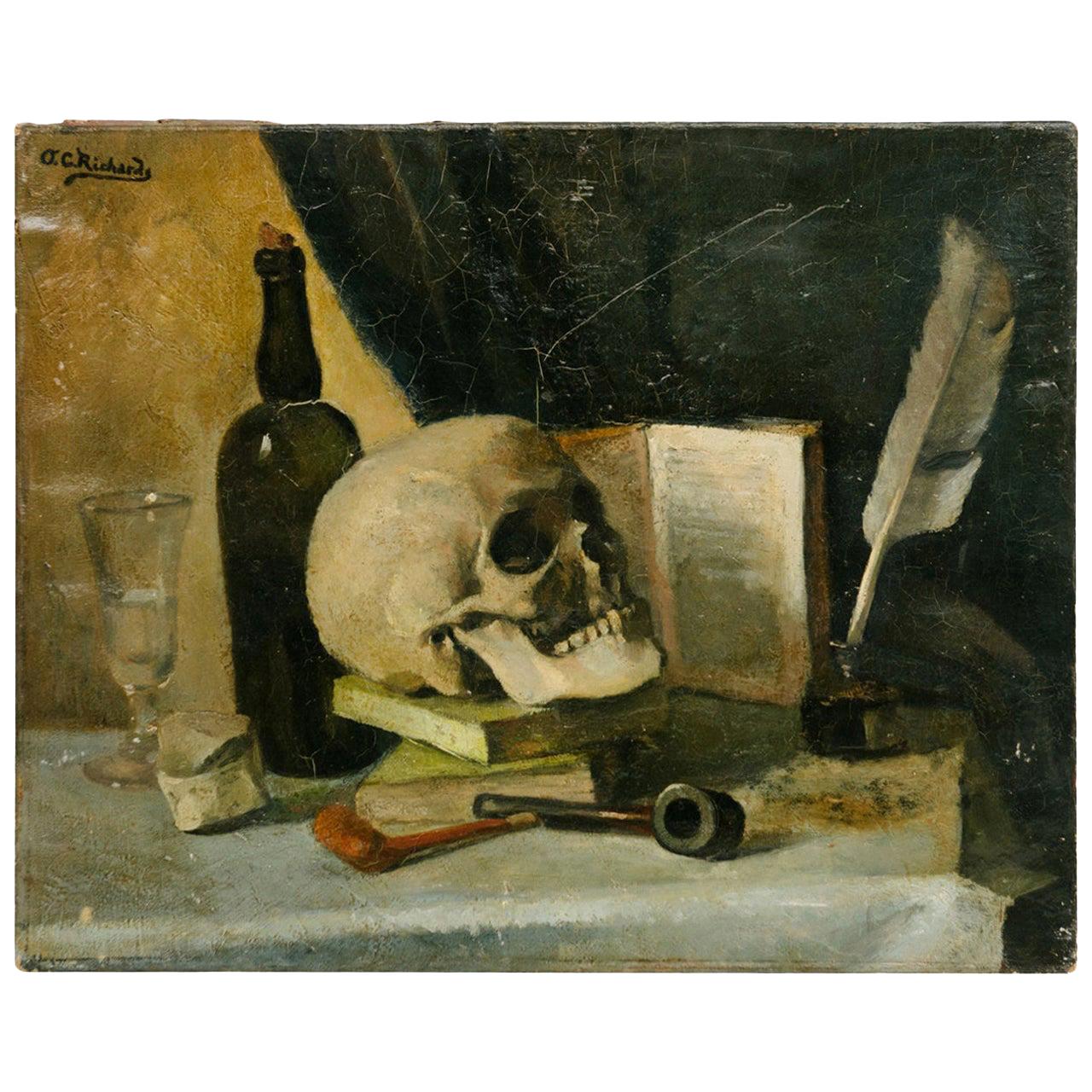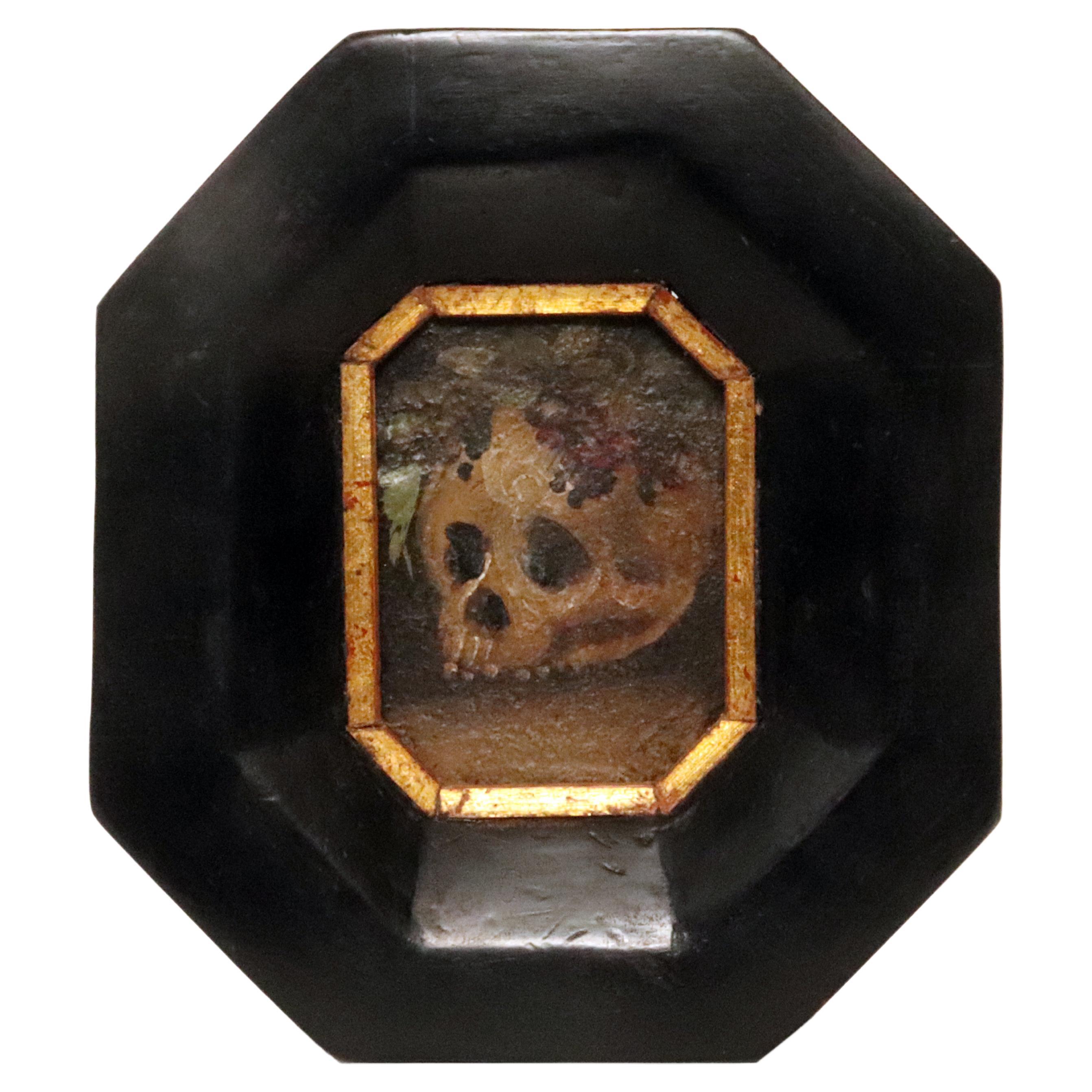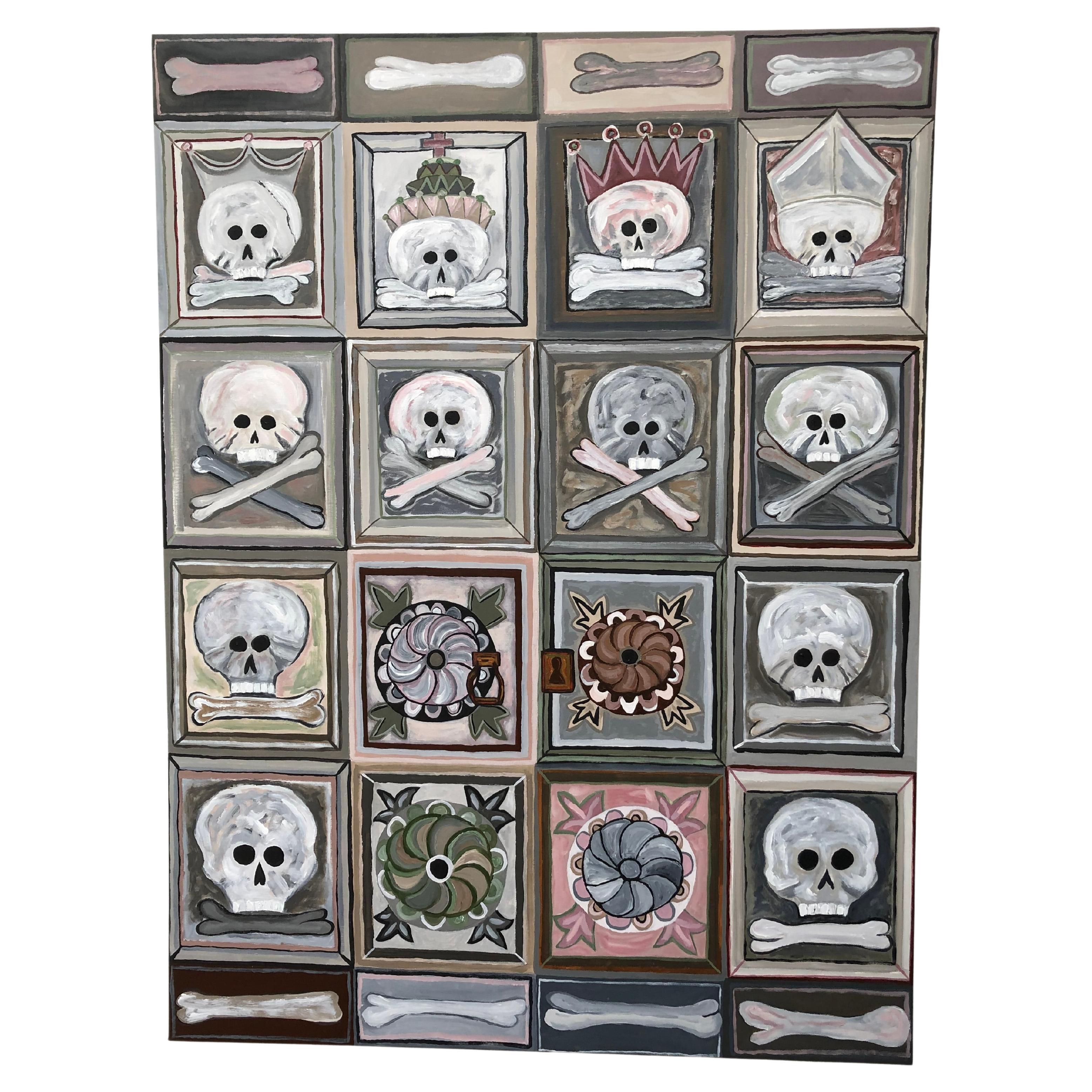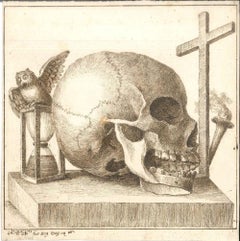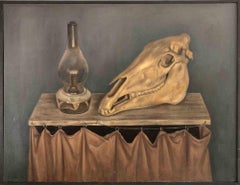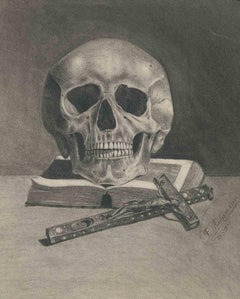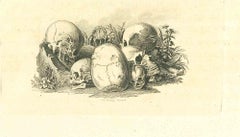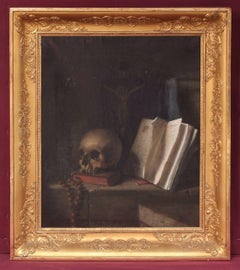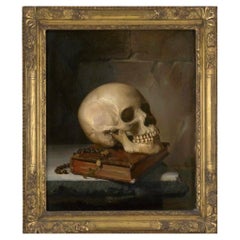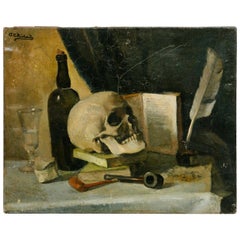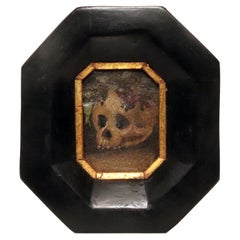Items Similar to Skull with Sacred Writings and Tablets of the Law - Tempera on Cardboard
Want more images or videos?
Request additional images or videos from the seller
1 of 4
French Painter 18th CenturySkull with Sacred Writings and Tablets of the Law - Tempera on Cardboard18th Century
18th Century
$6,577.44
£4,863.89
€5,500
CA$9,102.19
A$10,130
CHF 5,273.92
MX$122,330.58
NOK 66,139.81
SEK 62,473.21
DKK 41,891.74
About the Item
Skull with Sacred Writings and Tablets of the Law is a superb and colorful tempera on cardboard, realized in 1766 by an anonymous artist of the French School of XVIII century.
On the back of the frame, there is an antique cardboard label comìng from the original assembly with the written in black ink that points out the author: "Peint (...) M.lle Becquey de Viliers à Paris 1766".
In excellent conditions, including a modern wooden frame, cm 25 x 26.5.
There are deep religious meanings behind this composition with a skull leaning on books and surrounded by Sacred Writings, Tablets of Law, an hourglass, a crucifix, and some compasses. The theme of the vanitas, the fleetingness of time are the elements unify the composition.
It is amusing to read the hand-written and perfectly readbles religious warnings or the preys under the skull!
- Creator:French Painter 18th Century
- Creation Year:18th Century
- Dimensions:Height: 9.77 in (24.8 cm)Width: 10.48 in (26.6 cm)Depth: 0.48 in (1.2 cm)
- Medium:
- Movement & Style:
- Period:
- Condition:Insurance may be requested by customers as additional service, contact us for more information.
- Gallery Location:Roma, IT
- Reference Number:Seller: M-1011751stDibs: LU65034194452
About the Seller
4.9
Platinum Seller
Premium sellers with a 4.7+ rating and 24-hour response times
1stDibs seller since 2017
7,669 sales on 1stDibs
Typical response time: 3 hours
- ShippingRetrieving quote...Shipping from: Monaco, Monaco
- Return Policy
Authenticity Guarantee
In the unlikely event there’s an issue with an item’s authenticity, contact us within 1 year for a full refund. DetailsMoney-Back Guarantee
If your item is not as described, is damaged in transit, or does not arrive, contact us within 7 days for a full refund. Details24-Hour Cancellation
You have a 24-hour grace period in which to reconsider your purchase, with no questions asked.Vetted Professional Sellers
Our world-class sellers must adhere to strict standards for service and quality, maintaining the integrity of our listings.Price-Match Guarantee
If you find that a seller listed the same item for a lower price elsewhere, we’ll match it.Trusted Global Delivery
Our best-in-class carrier network provides specialized shipping options worldwide, including custom delivery.More From This Seller
View AllSkulls - Pair of Original Ink Drawings by Alessandro Dalla Nave - Early 1800
Located in Roma, IT
Skulls is a lot composed by two original drawings, Skull with hourglass and owl and Skull with Candle leaning on Book realized by Alessandro Dalla Nave.
Skull with hourglass and owl...
Category
Early 19th Century Modern Figurative Drawings and Watercolors
Materials
Ink
Still life with Skull - Oil paint - 20th Century
Located in Roma, IT
Still life with Skull is a modern artwork realized by Albin Sattler (1927 Lauterbach, Czechoslovakia - 1998 Munich) in 20th Century.
Mixed colored oil painting on canvas
Includes f...
Category
20th Century Contemporary Still-life Paintings
Materials
Oil
Memento Mori - Drawing attr. to Franz Biedermann - 1902
Located in Roma, IT
Memento Mori is a modern artwork realized by Franz Biedermann (attr.) in 1902.
Large-format drawing depicting a skull lying on an open book, in front of a large crucifix...
Category
Early 1900s Symbolist Figurative Drawings and Watercolors
Materials
Paper
Skulls - The Physiognomy - Etching by Thomas Holloway - 1810
By Thomas Holloway
Located in Roma, IT
Skulls is an etching realized by Thomas Holloway for Johann Caspar Lavater's "Essays on Physiognomy, Designed to Promote the Knowledge and the Love of Mankind", London, Bensley, 1810.
Good conditions.
Johann Caspar Lavater was a swiss theologian and philosopher known throughout Europe for his studies on physiognomy. Following the physiognomy tradition of Della Porta and of many Renaissance and Baroque philosophers, he believed that the character of a person could be elucidated through examining their “lines of countenance" i.e. tracing a profile outline portrait. Being able to "read outside" was the key to "know the inside". Lavater's thought largely influenced Art in the late 18th and early 19th century, as in the case of Johann Fuseli and William Blake (who realized two etchings for Lavater's English edition of his Essay).
Lavater was convinced that he could show his theories by analyzing the portraits of some of the main historical figures of the past, in some cases taken from paintings or (mainly for antiquity...
Category
1810s Modern Figurative Prints
Materials
Etching
$215 Sale Price
40% Off
Skull - Drawing by Leo Guida - 1976
By Leo Guida
Located in Roma, IT
Skull is an original artwork realized in 1976 by the italian Contemporary artist Leo Guida (1992 - 2017).
Pencil drawing on ivory-colored paper.
Hand-signed and dated on the l...
Category
1970s Contemporary Figurative Drawings and Watercolors
Materials
Pencil
Skull - Drawing by Leo Guida - 1976
By Leo Guida
Located in Roma, IT
Skull is an original artwork realized in 1976 by the italian Contemporary artist Leo Guida (1992 - 2017).
Pencil drawing on ivory-colored paper.
Hand-signed and dated on the lo...
Category
1970s Contemporary Figurative Drawings and Watercolors
Materials
Pencil
You May Also Like
Painting 18th Century Vanitas Still Life Skull Religion Esotericism Occult
Located in Saint-Ouen, FR
Vanitas 18th century
French School
Oil on canvas
Old frame gilded with gold leaves
Dim canvas : 73 X 60 cm
Dim frame : 93 X 80 cm
Certificate of authenticity
Category
Late 18th Century Old Masters Still-life Paintings
Materials
Oil
Early 19th Century French School Vanitas Still Life Oil Painting on Canvas
Located in London, GB
Antique Vanitas Oil Painting, Antique Memento Mori Oil Painting, Antique Skull Oil Painting, Gothic Antique Painting, 19th Century Vanitas Still Life Oil Painting.
Early 19th Century French Vanitas Oil Painting on Canvas.
The Old Master Vanitas Still Life Painting depicts a skull, book and rosary.
Oil on canvas, lined. Unsigned.
In gold gilt period frame.
Very well painted, attractive & highly decorative Vanitas skull...
Category
Antique Early 19th Century French Gothic Paintings
Materials
Canvas, Wood, Giltwood, Paint
19th Century Signed Orren C. Richard Skull Still Life Oil Painting
Located in Houston, TX
Memento Moro still life oil painting. Remains in stunning original condition. Signed by the artist, Orren C. Richards, in upper left corner.
Category
Antique Late 19th Century Paintings
Materials
Canvas
Oil painting on iron plate depicting a Vanitas, Italy late 17th century.
Located in Milan, IT
Oil painting on iron plate, depicting a Vanitas with skull and fruit. Octagonal frame in interlocking ebonized wood with flaring to match the painting and gold profiling on lead. Ita...
Category
Antique Late 17th Century Italian Paintings
Materials
Iron
Vanitas by Catherine Jansens (Born in 1949)
By Catherine Jansens
Located in Gent, VOV
Catherine Jansens’ watercolour titled "Vanitas" is a compelling still life that delves into the theme of the transience of life and the inevitability of death—an idea traditionally e...
Category
20th Century Still-life Paintings
Materials
Watercolor
Large Original Painting on Canvas of Skull Motif Italian Door
By Fay Sciarra
Located in Hopewell, NJ
Large new bold rectangular painting on canvas that's a graphic rendering of skulls and bones inspired by a carved door seen in Matera Italy. Colors include a striking palette of blac...
Category
21st Century and Contemporary American Modern Paintings
Materials
Canvas, Acrylic
$1,650 Sale Price
25% Off
More Ways To Browse
18th Century French Art
Antique Law
18th Century French Paintings
Antique French Label
Antique Tablet
Painting With A Skull
Antique Tempera Painting
Antique Skull
Paintings 18th Century Religious Paintings
18th Century Compass
Wooden Compass
Antique Hourglass
Antique Cardboard Frame
French Crucifix
Vanitas Skull
Antique Wooden Crucifix
Antique Wooden Compass
Teds Heads
